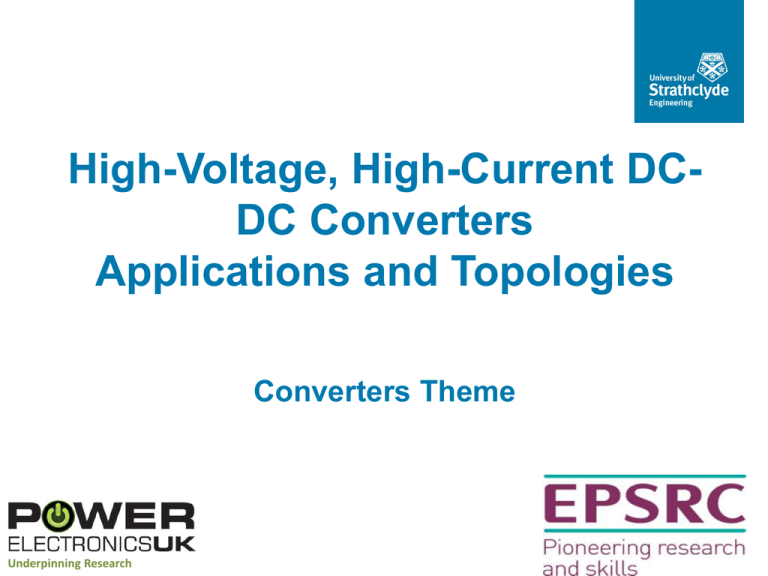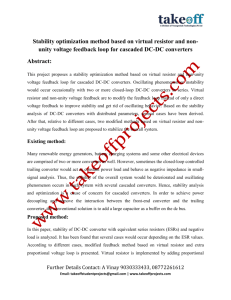Prof Stephen Finney - Centre for Power Electronics
advertisement

High-Voltage, High-Current DCDC Converters Applications and Topologies Converters Theme Underpinning Research DC Power Networks • DC power can reduce losses and allow better utilisation of conductor ratings. • Power Networks must accommodate growing levels of power electronic connected generation and loads: • Most power electronic converters operate from DC. • Elimination of intermediate AC interconnection appears to reduce the number of conversion stages required. Underpinning Research Advantages of DC Power Networks Potential Benefits • Elimination of charging currents and • Reduced conductor losses • Reduced size and weight ? Underpinning Research Ac vs. dc distribution for off-shore power delivery Wang, F.; Yunqing Pei; Boroyevich, D.; Burgos, R.; Khai Ngo Industrial Electronics, 2008. IECON 2008. 34th Annual Conference of IEEE Reduced Conversion Stages dc/AC AC/dc G G ac/dc dc/ac dc/dc dc/AC ac/DC DC/ac DC/dc G Loads ac/dc Loads G ac/DC Underpinning Research Offshore Wind Connection MVAC/ HVDC DC/DC converters required to interface Generation- Collection Network Collection Network-Transmission Underpinning Research DC-DC converters must be rated for the region ≈3kV: 50kV Collection ≈50kV: 800kV Collection MVDC/ HVDC DC/DC Converters • Different DC voltages may be preferable at generation, collection/distribution and transmission stages. • DC/DC converters will be required to interface these stages. • HVDC networks may require DC/DC interface to connect different transmission (legacy) voltages. • Meshed DC networks may require DC/DC converters to provide auxiliary functions. • Balancing power flows in meshed DC networks • Controlling DC fault currents stages required. Underpinning Research DC-DC converter options Vin Switching stage with DC-offset DC Power Transfer Filter Vout • Single switching stage required. • Poor device utilisation (Switches must be rated for highest voltage and current ) • High switching frequency required to minimise filter Vin Switching stage with AC output Passive Network And/Or Transformer Rectification stage Switching Frequency Power Transfer Vout • Two switching stages required. • Transformer may be used to improve device utilisation • Resonant passive network may be used to reduce switching loss Underpinning Research Challenges for high capacity DCDC converters • Voltage: Voltages exceed the capabilities of single switching devices. • Series connection • Multi-level/modular techniques • Efficiency: The use of DC/DC for network applications must not compromise gains in system losses. • Size: Raised switching frequencies necessary in order to reduce size of passive components and coupling transformers. • Maintain device switching speeds • Soft switched circuits • Isolation: Galvanic Isolation • Transformer coupled circuits Underpinning Research DC-DC Transformer: Requirements • • • • • • • • • • • Voltage step up/down using an AC transformer. Device Utilisation and galvanic isolation. Lower medium frequency range (< 1 kHz). Device constraints and switching losses. Not resonant. Avoiding high internal voltage stresses and tuning problems. Modularity. Facilitating manufacturing and installation. DC fault blocking. Protection and reliability of supply. Bidirectional. Underpinning Research Series Connection • Dynamic voltage sharing may limit the achievable switching speed of individual devices. • HVDC links have shown that the use of series connection of IGBTs is feasible to the region of ±200kV • Power frequencies up to 1-2kHz may be achievable to reduce the size and weight of magnetic components. This will result in overall semiconductor losses of a similar level to that of a3 two-level HVDC converter. • Switching large voltage steps, such as 400kV or higher, at 1 or 2kHz impresses extremely high dv/dt upon passive components and interfacing transformers. Underpinning Research DC-DC Transformer: Dual Active Bridge, Series Devices Underpinning Research AC transformer Modularity Not resonant dv/dt stress Bidirectional Voltage sharing DC fault blocking High frequency Multi-Level Techniques • A number of multilevel DC/AC topologies exist which could be applied to transformer coupled DC-DC converters • Multi-level can decouple switching frequency from output power quality in DC-AC converters working at power frequencies of 50-60Hz resulting in significant efficiency improvements.. However: • Advantages for DC-DC conversion are not clear since efficiency will reduce if raised power frequency employed to reduce transformer size. • Capacitor energy storage requirement and resulting volume can be high. (Reduction in capacitor requirement with raised power frequency.) Underpinning Research DC-DC Transformer: DAB with multi-level converter Front-to-front MMC connection Underpinning Research AC transformer MMC half-bridge cells Not resonant Acceptable (Quasi-two level) Bidirectional Equal static and dynamic sharing DC fault blocking Low frequency (250-500Hz) DC-DC Transformer: MMC Topology Quasi Square-Wave Switching Front-to-front MMC connection • Very small cell capacitance (small cell volume). • Very small arm inductance. • Device voltage limited by cell capacitance. • Device switching speed does not compromised for voltage sharing. • Controlled dv/dt • The arm current contains no common-mode component, except during staircase switching periods. DC-DC Transformer: Simulation Single Q2L converter N=10 10+1 level output Underpinning Research DC-DC Transformer: Simulation Single Q2L converter Ccell=50μF Ripple = 3% Underpinning Research DC-DC Transformer: Simulation Single Q2L converter 2% ripple Transformer Array i0utput Converter Array Input Converter Array Modular Transformer Coupled DC-DC The DC-DC converter consists of an array of transformer coupled DC-DC converters each of which operates at a voltage compatible with a single power semiconductor device. DC-DC converter modules can be sized to optimise size and efficiency independent of system voltage requirement. Modular Transformer Coupled DC-DC • Reduced current stress: Input parallel connection reduces switching device current stress • Reduced voltage stress: All modules operate at a voltage compatible with a single power semiconductor rating. • Size and Weight: Switching frequency similar to established DC/DC converters. Significant reduction in the size and weight of the magnetic component possible. • Redundancy: High availability could be achieved by introducing the desired level of redundant cells • Modular Structure: Standardised components reduces cost of converter • Disadvantages: Multiple transformers, isolation, complex control. Modular Transformer Coupled DC-DC Building Blocks Front-end Inverter Unit M1 Transformer Unit M2 Output Rectifier/Inverter Unit M11 M22 85mH Lout1 10mH Vin = 1kVdc Inductor Unit Lk Cin M4 M3 Cout T1 1:2 Lout2 85mH M44 M33 Vout = 1kVdc – 1.5kVdc Iout = 10A Active bridge can be replaced by rectifier for unidirectional power flow Building blocks may be standard DC-DC converter modules sized to optimise size and efficiency independent of system voltage requirement. e.g. Single Dual active bridge may be used for bidirectional power flow. Underpinning Research Modular Transformer Coupled DC-DC Input Parallel +Series -Output Series Input Parallel -Output Series Module 1 iin1 Tr1 Vcd 1 Vo1 iin 2 Module 2 Tr2 Vo 2 Vin Module n iinn Trn Von Module n+1 iin ( n 1) Tr(n+1) Vcd 2 Vo Vo ( n 1) iin ( n 2) Module n+2 Tr(n+2) Vo ( n 2) Module 2n iin (2 n) Tr2n Vo (2 n ) System voltage and current requirements can be met through a combination of parallel and series connection at both input and output terminals. Cell Balancing Control Control must control output voltage and balance cell voltage. Unbalanced cell parameters will lead to unbalanced cell voltage and poor dynamics Common duty cycle may fail to respond to parameter mismatch or cell un-balance Underpinning Research Individual cell control with current demand offset to correct cell unbalance Cell Balancing Control Module 1 Module 2 Module 3 Module 4 Test 1 Output Capacitance 60μf 50μf 50μf 50μf Test 2 Transformer Turns Ratio 1:1.125 1:1 1:1 1:1 (a) (b) Response to step change in load voltage associated with mismatched output capacitance (a) module output voltage (b) output voltage mismatch between Module 1 and Modules 2, 3 and 4 Fault Ride-Through + Vo2 - No. 1st 2nd 3rd 4th 5th Fault Type Short-circuit fault on the module end side Open circuit fault Current transducer fault Over-current fault Master converter fault Short circuit fault Non-dedicated master control scheme Fault Ride-Through +20% mismatch Master converter fault at t=50ms +10% mismatch System Specifications output voltage module output voltage module inductor current Conclusions The lack effective DC/DC converters remains one of the barriers to expansion of DC power networks. High capacity DC/DC converters are feasible. A wide range of topologies are under investigation but it is unclear if any deliver the advances in efficiency and power density necessary for utility scale DC applications. Underpinning Research



